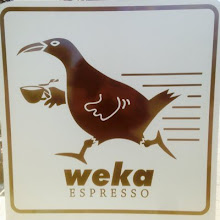Ten years ago, the new millennium was about to dawn. The Chatham Islands are 45 minutes ahead of mainland New Zealand, making them the first inhabited location to see the sunrise each day. Although Pitt Island is technically further east, the celebrations were held on the east coast of Chatham, which hosted a raft of television crews and visitors who trekked over a few kilometres of farmland to find the right spot. Our convoy of six 4WD vehicles bobbed up and down as we climbed higher and higher; my 22-month-old nephew loved all the bumps! We inadvertently took a wrong gate somewhere along the way. However, the first place we stopped gave us a distant view of Pitt Island, as well as the lovely different colours lapping the cliffs on the sea below us.
We found the correct gate and proceeded another couple of kilometres up the hill before getting out to walk the final distance across more farmland. Some of our family were at the millennium celebrations ten years ago, but couldn't accurately recall the exact spot where they took place. We were looking for a memorial plaque to confirm the location; we couldn't find it, and later were told that it had been shifted into the memorial garden at Waitangi (town). Once again, the view was beautiful and the walk made us feel virtuous after so much indulgence over Christmas. This is a view of the three rocks known as The Pinnacles:
Once we hit the main road again, we drove out further east towards Manukau to visit the memorial statue of Tommy Solomon, the last-known full-blooded Moriori who died in 1933. The statue is a much slimmer representation of his full girth. His coffin was made by my great-uncle and his grave dug by my great-grandfather.
Owenga is a small settlement near the east coast of Chatham Island. Its wharf was recently rebuilt and is mainly use as an alternative fishing port to Waitangi. Today, the water was uncharacteristically clear and calm. Several years ago, my uncle's fishing boat was lost in this very area in a freak storm; it's hard to imagine on such a beautiful day like this.
As we walked down to the end the wharf, we came across some locals who were fishing off the edge with hand lines. They caught a conger eel, which apparently is too bony to eat so would be used as crayfish bait. Next to the eel is a blue cod they had caught earlier, also by hand.
 Slightly along from Owenga and heading back towards town is Shelly Beach, so named because it is where thousands of sea shells wash up from the sea. Last time I was there I collected several orange-coloured scallop shells, large paua pieces, and pink mussel shells, most of which have done the rounds of several friends' classrooms since then. I absolutely love natural paua (unpolished, and not the vivid blues and greens used for tacky souvenirs) and have a range of paua jewellery pieces and shells. This time, I gathered some cream-coloured queen paua shells to bring back and add to my collection.
Slightly along from Owenga and heading back towards town is Shelly Beach, so named because it is where thousands of sea shells wash up from the sea. Last time I was there I collected several orange-coloured scallop shells, large paua pieces, and pink mussel shells, most of which have done the rounds of several friends' classrooms since then. I absolutely love natural paua (unpolished, and not the vivid blues and greens used for tacky souvenirs) and have a range of paua jewellery pieces and shells. This time, I gathered some cream-coloured queen paua shells to bring back and add to my collection.







1 comment:
I love shells... I never find any when I AM at a beach... and I am far from one! Manitoba has many lakes... but hours away from any oceans.
Post a Comment